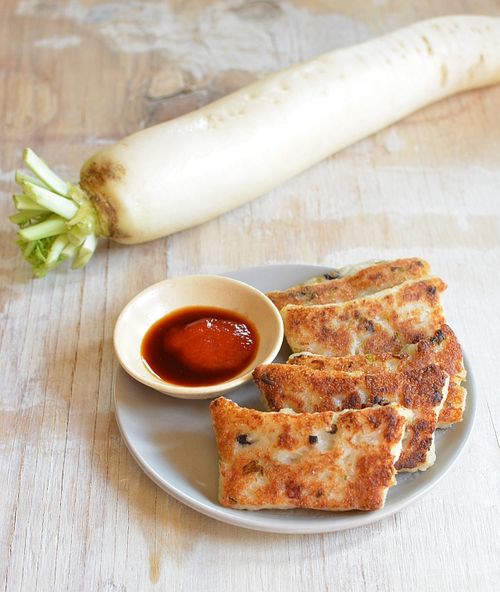Do you revisit recipes to see if you can better them? I do. It’s practically a professional obsession. My friend, veteran cookbook author Molly Stevens and I were just talking today about how our curiosity pushes us to tinker and tweak. Sometimes, however, it’s a vicious cycle and you have to know when to call it quits. Obsessions can turn into distractions.
Yesterday, I took another look at a dim sum recipe that I’d worked through years ago. It’s a daikon radish cake – the pan-fried white slabs that you get at dim sum. When done right, luo bo gao has a lovely crisp outside and tender inside. When done poorly (the cook under-fries), the radish cakes are more soft than crisp.
Luo bo gao is easy to make and on this attempt, I wanted to check three things: (1) Am I okay with the softer texture of using only rice flour; (2) can I use rice flour from the health food store instead of Asian rice flour; and (3) can I freeze the finished cakes to bank my effort?
The original recipe came from Wai Hon Chu’s The Dumpling: A Seasonal Guide (William Morrow, 2009). Wai learned from his father to add wheat starch (a Chinese ingredient used for har gao dumpling dough and some noodles) to firm up the cake. Many recipes use just rice flour. While I like Wai’s texture a lot, I was prompted to try just rice flour to accommodate people with serious gluten issues. Wheat starch may have traces of gluten in it.
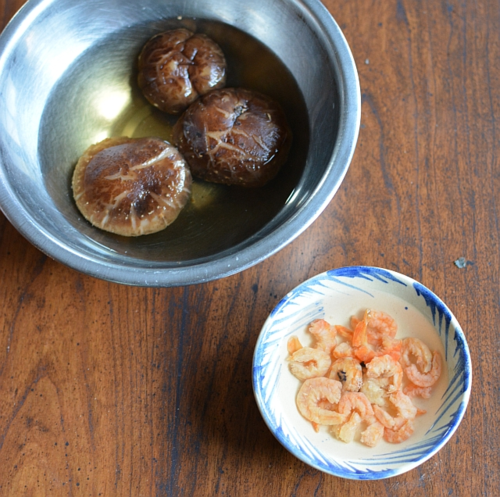
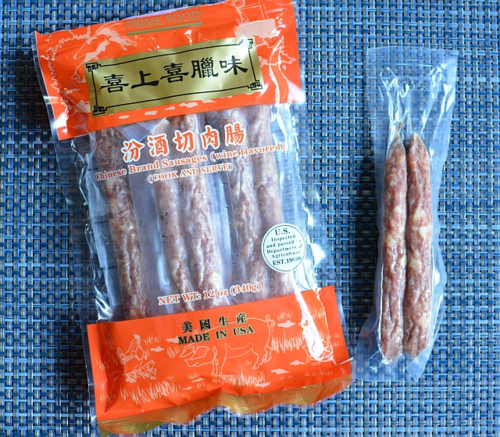
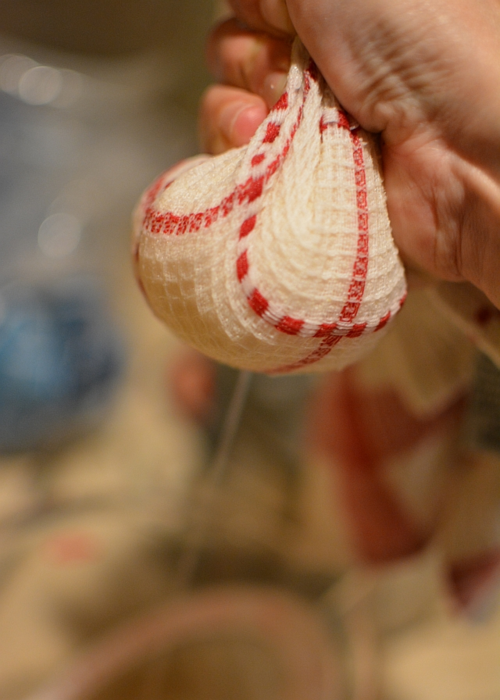
The rice flour at mainstream markets is finer these days than in the past so I wanted to test it here. Usually I use Asian rice flour from Thailand, which is super fine and soft. And, we rarely are able to each up an entire batch so I opted to steam the mixture in mini disposable loaf pans.
The results: (Hurray!) The health food store flour worked out just fine. I opted out of the wheat starch, and didn’t mind the resulting softer texture. It was somewhat creamy. I venture that you can try cornstarch instead of wheat starch if you wanted a stiffer rice cake. (Give it a try and let me know!)
The little loaf pans created a funny shape that I found charming. The typical radish cake is a rectangular slab. I threw one of the loaf pans into the freezer overnight and defrosted it this morning. No problem! I often eat these rice cakes with dumplings and having them around to thaw and pan-fry makes it easy for me to build a dumpling menu.
The thing to watch out for is this: when stirring in the rice flour mixture, use care and stir it in gradually. I made a mess of my stove last night.
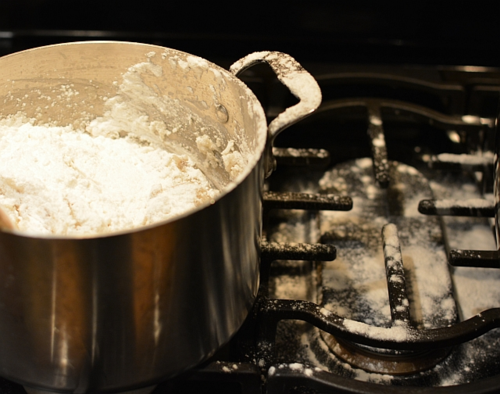
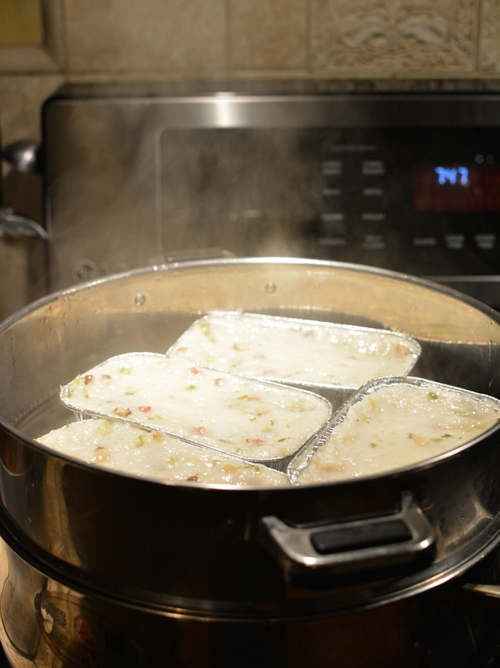
If you can’t get dried shrimp, use more mushroom or sausage (or bacon). Dried shrimp and Chinese sausages are sold at Chinese and Southeast Asian markets. Instead of bacon, a smoked sausage may be a good substitute. Choose one with fat and flavor.
I’ve just offered you more ideas because they’re in my head, part of my ongoing curiosity. A little obsession can be good, right? If you tweak the recipe or have ideas to share, add them here. If you want to get deeper into dim sum and dumplings, search this site for "dumpling" recipes or Asiandumplingtips.com. There's also my book, Asian Dumplings and online class.
Recipe
Daikon and Rice Cake
Luo Bo Gao
Yields: 6 to 8 servings
Ingredients:
- 16 medium or large dried shrimp
- 3 medium-large dried shiitake mushroom
- 3 green onions
- 2 links Chinese pork sausage (la chang, lap xuong) or 2 ounces (60 g) bacon, diced or chopped (about ⅔ cup)
- 1 pound (450 g) daikon radish
- 2 cups (10 oz / 300 g) white rice flour
- ¼ cup wheat starch (optional for firm texture)
- 1 teaspoon salt
- 1 teaspoon sugar
- ½ teaspoon freshly ground white pepper
- Canola oil, for pan-frying
- Soy sauce or Maggi (!)
- Hot sauce, such as Chile Garlic Sauce or Sriracha
Method
- Put the dried shrimp and mushroom in two separate small containers. Pour hot water over both to just cover and soak for 30 minutes, or until softened. Meanwhile, finely chop the green onion and set aside. Dice or chop the sausage or bacon and set aside.
- Peel the daikon and grate it through the small holes of your grater onto a kitchen towel. Bring together the ends of the cloth and twist to squeeze out as much of the liquid as you can into the bowl. Measure out the collected juices. The shrimp and mushroom should be soft by now; strain and add their soaking liquid to the daikon juices. Add enough water to the juice to make 3½ cups, then dump the water into a medium pot. Add the daikon and bring to a boil over high heat, lower the heat to simmer, cover and cook for 5 minutes.
- Meanwhile, trim and chop the mushroom. Finely chop the shrimp. Set aside. In a bowl, stir together the rice flour, wheat starch, salt, sugar and pepper. Put near the stove.
- Uncover the pot of daikon, add the sausage, shrimp, mushroom, and green onion. Cover and cook for 5 minutes longer. Remove from the heat. Slowly add the rice flour mixture and vigorously stir to combine well. The mixture will be thick, sticky and lumpy.
- Lightly oil 4 small loaf pans or two 9-inch (13.5 cm) round cake pans. Use a wet spatula to divide the daikon mixture among the pans. Flatten it out and pat down. Steam over boiling water for 30 to 40 minutes. Cool completely on a rack. Refrigerate up to 3 days or freeze up to a month.
- Unmold and use a wet knife to slice or cut into wedges and pan-fry in a skillet with a splash of oil. Use medium heat and expect it to take roughly 2 minutes per side to achieve a brown, crisp surface. Eat with soy sauce and hot sauce.
Related post: After making a batch, use some for a Saigon street food -- fried daikon and rice cakes with egg and sriracha soy sauce (banh cu cai bot chien). Jump to the recipe.













